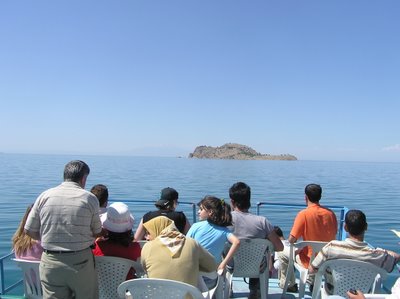
If you find yourself in far eastern Turkey, in the environs of the breathtakingly beautiful Lake Van, you are probably there to visit Akdamar Island. Such was the draw for me. Akdamar was the locus in this part of "Armenia" from the 900s until about 1918 or so, when the last of the local Christians were killed in the Armenian genocide. At one time, the island housed a royal palace complex and an extensive monastery, in addition to the cathedral church. The church served a comunity of over 140 area churches and 40 monasteries. Today, only the church is left, and it has stood vacant since the end of the First World War.
The church is currently undergoing a government-sponsored restoration, after decades of neglect. Admittedly, this may be cause for concern--the restoration of an ancient Armenian church by the Turkish authorities--but I will give them the benefit of a doubt. Ankara's aggressive PR campaign and overtures to join the EU undoubtedly play a part in this. That, and the dawning realization that there are tourist dollars in these crumbling Christian ruins. Day in, day out, three ferries continuously ply the 2 kilometers between shore and island. Our ferry carried 36 passengers--35 Turks and 1 Texan. I believe that this is a hopeful sign. Turkish nationals are apparently interested in visiting Akdamar and picnicking among the jumble of ancient Armenian tombstones with their huge, ornate crosses. The point is this: there is no way to "Turkify" Akdamar. It is wholly, completely, totally Armenian--and Christian.
My 35 Turkish fellow travelers broke down into 19 men and 16 women. In my journey throughout Turkey, I took to observing the number of women wearing headscarves. They have become common (and an issue) in Turkey only in recent years--tied to political and social conservatism, a "return to traditional values," if you will. I find the wearing of headscarves to be an obviously inexact, but not unreliable, measure of Islamist sentiment.
Lake Van lies in far eastern Turkey, in supposedly one of the most conservative regions of the country. Nevertheless, only 4 of the 16 women wore headscarves. Again, I find this hopeful, and is illustrative of the complex and changing nature of Turkish society.
The Islamist agenda, just as the practice of Islam itself, is somewhat different in Turkey. The Turks are both staunchly Muslim and secular at the same time. This dichotomy precludes making hard-and-fast conclusions about the culture. In fact, the only place I visited where all women wore headscarves was in Yusefeli, deep in the mountains of northeastern Turkey, although I am sure that is also the case in most rural villages, as well. I have been told that for many women, the wearing of the headscarf is more of a political statement than a show of religious fundamentalism. Throughout eastern Turkey, I could draw no firm conclusions--some women wore them, many did not.
There seemed to be no sifting-out between those who did and those who did not. Young women in headscarves--or even dressed "full burkha"--walked arm-in-arm with girls without the scarf who wore western-style blue jeans. My guide told me that each girl made the decision for herself, that there was no pressure one way or the other. I doubt seriously if this is the case in many rural areas, but otherwise I suspect it may be so. What is frowned-on, however, by all parties, is the wearing of short skirts. This is really just not done in Turkey.
I did not notice appreciably more headscarves in eastern Turkey than in Istanbul, as one might expect. In fact, Istanbul is such a cosmopolitan place that it is much like New York in that you are liable to see anything there. For example, the old Greek Phanar district has been largely taken over by poor, fundamentalist Muslims from eastern Turkey. The bearded men are in woolen skullcaps and the women in black burkhas--some with eyes and nose exposed, and some with only the eyes exposed. You might as well be in Kabul. (And believe me, this dress--and what is signifies--is as alarming to most Turks as it is to us). Yet, just across the Golden Horn, along the Istiklal Cadessi, I had to look, and look, and look to spot even one woman in headscarf among the crush of shoppers. As I sat in the sidewalk restaurant, observing, I eventually counted three.
Most of Istanbul falls between these two extremes. Many young Turkish women who opt for the headscarf also wear attractive white close-fitting tunic-style coats. Older women often wear the ubiquitous, shapeless floor-length overcoats endemic to Turkey. They come in two colors: gray and taupe, and they wear them regardless of how hot it is outside. Unfortunately, women who wear these seem cursed to assume their shape. On the other hand, young women in headscarves are often dressed elegantly from head to toe, with special attention to footwear.
I am trying not to obsess on this issue, but merely attempting to gauge the extent and direction of Islamism in the one Muslim country in which I have some limited experience. Blanket assumptions about the Middle and Near East can be ill-informed, and as we are finding out, dangerous. My gut feeling is that Turkey's westward orientation is irreversable; no matter how long it takes, they will eventually join Europe. But they will do so as a decidedly Muslim nation. And Europe, no longer Christian in any real sense, but retaining enough of a veneer of such in their collective memory to be alarmed, is scrambling to confront this dilemma. I am also convinced that if the West ever comes to an accomodation or truce with Islam--and clearly, I am not at all hopeful that such will ever, or should ever occur--it will have to be on the Turkish model.
No comments:
Post a Comment